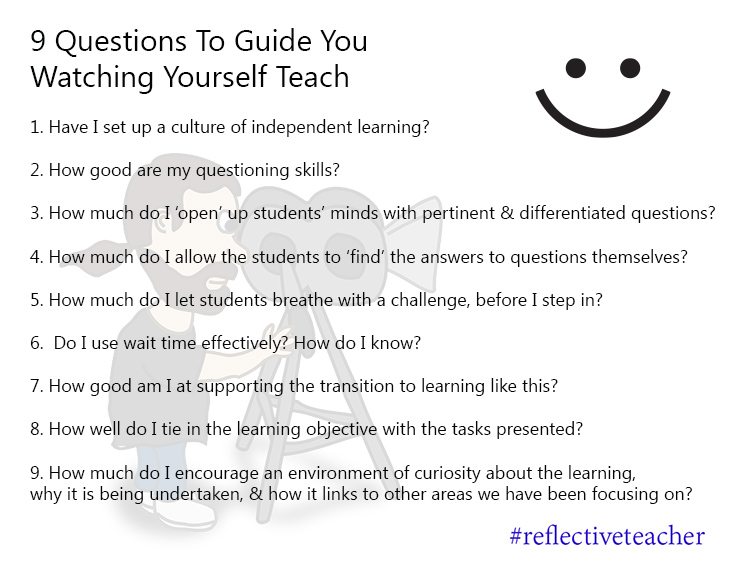
Reflect Critically On Your Own Teaching With These 9 Questions
Video your teaching, and see what really happens in your classroom.
That is my exhortation to you, from a recently converted disciple of such professional development. I don’t mean for the sake of observing student behavior, although you will see some incredible things at times but more so to measure your skill in creating a classroom culture of challenge, and curiosity, where intrinsic motivation and independent learning are the primary focus.
A major focus for all schools now is the idea of progress. At all times students must be seen to be progressing. Traditionally, such progress is measured through assessment, in both formative and summative modes.
See also 20 Questions To Clarify Your Teaching For 2023
Whilst this approach is incredibly powerful, it does not present the whole picture of a student’s movement. The process of a student arriving at a learning objective is equally important and powerfully enlightening in terms of planning.
Videoing allows me to see if I am simply feeding the students info, or if I am guiding them to finding and discovering it.
The distinction is massive and has great implications for the notion of what constitutes effective learning, yet it took observations of my videos for the levels and ratios of both styles to become apparent to me. It took videoing to present observation of my skill in addressing these vital questions:
How much I have set up a culture of independent learning?
How good are my questioning skills?
How much do I ‘open’ up students’ minds with pertinent and differentiated questions?
How much do I allow the students to ‘find’ the answers to questions themselves?
How much do I let students breathe with a challenge before I step in?
How much do I use wait time effectively?
How good am I at supporting the transition to learning like this?
How well do I tie in the learning objective with the tasks presented?
How much do I encourage an environment of curiosity about the learning, why it is being undertaken, and how it links to other areas we have been focusing on?
When I first watched myself back I realized that these considerations were alarmingly lacking. And while I have had to really take stock of my teaching skill in implementing such ideals, there was and still, is another thing getting in the way of making such pedagogy a smooth and seamless experience.
I think I know what it is.
When watching the videos it is strikingly clear that the students are not used to such a learning culture. Many of them have great difficulty in making progress on their own. They seem to have fallen into a pattern of passively learning material, completing exercises with little connection to anything other than the moment, and worst of all, easily giving up when the challenge is ostensibly too difficult (often at the very first moment of difficulty).
The consequence is that often I have had a classroom with an overwhelming vibe of student angst and annoyance at not being told the answers, and not being able to complete tasks quickly. At times students have literally challenged my teaching credentials.
Many times I gave in to such disharmony. In hindsight, and ironically, I gave in too easily. However, as I have evolved and learned to be patient in the method, it is becoming increasingly apparent that the students are slowly becoming more independent, and fighting that little bit harder to achieve an understanding of a task.
Recording Lessons For Teacher Professional Development
Whilst I still have a long way to go before I could say that I’ve mastered the process, I have experienced enough feedback to validate the paradigm. What is clear is that when I am successful in creating a culture of challenge, the students are able to transfer knowledge with more skill, and seem to be truly engaged in learning. When they push through the barriers and see that they actually can do it, they feel a sense of ownership with their progress.
And then the silver lining reveals itself in all its glory: it’s all without me having to extrinsically motivate the class in any way. The students just don’t need it. They actually don’t even want it. They know they’ve worked it out; they don’t need me to say so. And for the ultimate reversal, they actually vent their disappointment if I jump in too quickly with help. Then the classroom takes on a different vibe entirely: students suddenly seem thirsty!
For me, videoing has become an enormously useful measure of progress, as I can easily recall a series of videos to demonstrate how students and myself have made progress in learning in the classroom. I can see how my style has evolved to address the questions above. I can see how the students are adapting to the style, and how much more they are engaged, verbally, mentally, and physically, with peers and on their own. These are videos that I could show inspectors.
Whilst the road has not always been easy, like what I tell the students all the time, nothing any good and worth fighting forever is. I am fortunate and thankful that my current school, Marine Academy Plymouth, has the insight to encourage such an approach to professional development. Does your school?
